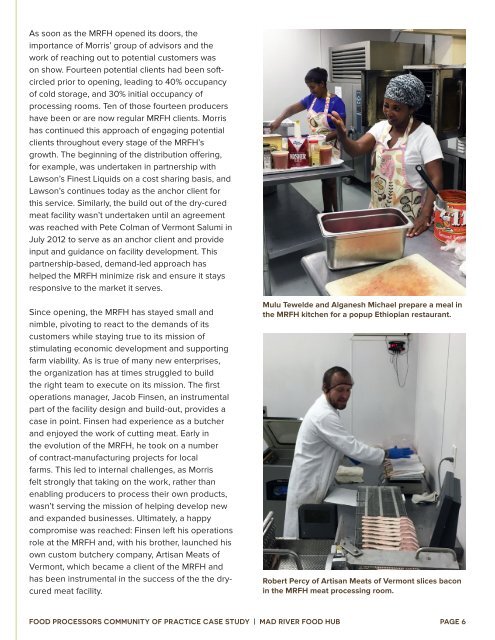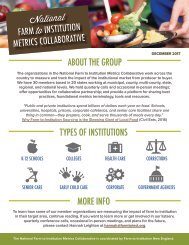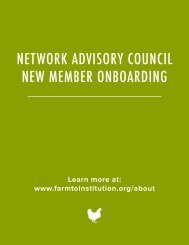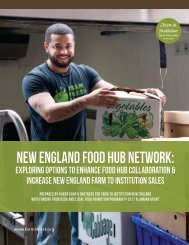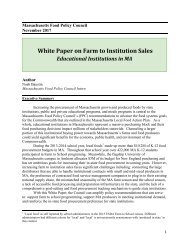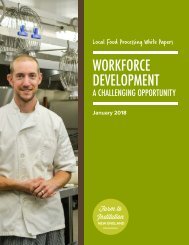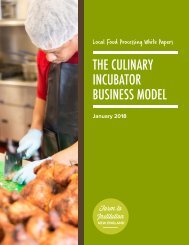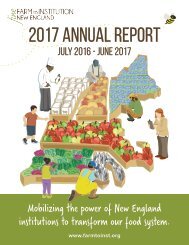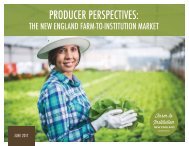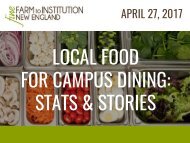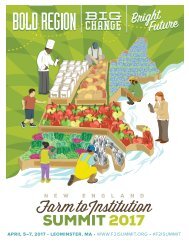Mad River Food Hub Case Study
Create successful ePaper yourself
Turn your PDF publications into a flip-book with our unique Google optimized e-Paper software.
As soon as the MRFH opened its doors, the<br />
importance of Morris’ group of advisors and the<br />
work of reaching out to potential customers was<br />
on show. Fourteen potential clients had been softcircled<br />
prior to opening, leading to 40% occupancy<br />
of cold storage, and 30% initial occupancy of<br />
processing rooms. Ten of those fourteen producers<br />
have been or are now regular MRFH clients. Morris<br />
has continued this approach of engaging potential<br />
clients throughout every stage of the MRFH’s<br />
growth. The beginning of the distribution offering,<br />
for example, was undertaken in partnership with<br />
Lawson’s Finest Liquids on a cost sharing basis, and<br />
Lawson’s continues today as the anchor client for<br />
this service. Similarly, the build out of the dry-cured<br />
meat facility wasn’t undertaken until an agreement<br />
was reached with Pete Colman of Vermont Salumi in<br />
July 2012 to serve as an anchor client and provide<br />
input and guidance on facility development. This<br />
partnership-based, demand-led approach has<br />
helped the MRFH minimize risk and ensure it stays<br />
responsive to the market it serves.<br />
Since opening, the MRFH has stayed small and<br />
nimble, pivoting to react to the demands of its<br />
customers while staying true to its mission of<br />
stimulating economic development and supporting<br />
farm viability. As is true of many new enterprises,<br />
the organization has at times struggled to build<br />
the right team to execute on its mission. The first<br />
operations manager, Jacob Finsen, an instrumental<br />
part of the facility design and build-out, provides a<br />
case in point. Finsen had experience as a butcher<br />
and enjoyed the work of cutting meat. Early in<br />
the evolution of the MRFH, he took on a number<br />
of contract-manufacturing projects for local<br />
farms. This led to internal challenges, as Morris<br />
felt strongly that taking on the work, rather than<br />
enabling producers to process their own products,<br />
wasn’t serving the mission of helping develop new<br />
and expanded businesses. Ultimately, a happy<br />
compromise was reached: Finsen left his operations<br />
role at the MRFH and, with his brother, launched his<br />
own custom butchery company, Artisan Meats of<br />
Vermont, which became a client of the MRFH and<br />
has been instrumental in the success of the the drycured<br />
meat facility.<br />
Mulu Tewelde and Alganesh Michael prepare a meal in<br />
the MRFH kitchen for a popup Ethiopian restaurant.<br />
Robert Percy of Artisan Meats of Vermont slices bacon<br />
in the MRFH meat processing room.<br />
FOOD PROCESSORS COMMUNITY OF PRACTICE CASE STUDY | MAD RIVER FOOD HUB PAGE 6


